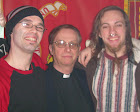
The Gay Brothers (1894?)
Part One
Vito Russo, in his book The Celluloid Closet (1976) gave us the first study of gay film. Even today, 35 years later, it remains a valuable reference. In his book, he claims that the Dickson Experimental Sound Film, which he calls The Gay Brothers, is the first gay film. Yet, when we look closely at the film, and the conditions under which it was produced, it seems less and less likely that it is truly a gay film, and that there are several other period films which have at least as strong a claim on the title.
I have long had an interest in film, and graduated with a second B.A. in Film Studies in 2006. My first BA, in English, I received in 1971. I am also gay, and have an interest in gay culture and its expression in film. I have just completed an MA in Film Studies, my thesis being titled Transgressive Masculinities in Selected Sword and Sandal Films, which dealt with items of gay interest. During my research I discovered that Vito Russo did not address all aspects of Hollywood film in his book, and, looking at The Gay Brothers, I was somewhat skeptical of his claims. The more I looked into the film, and studied it, the weaker Russo's claim seemed to become. I believe that two concerns were in force that motivated Russo's claim: 1) that he sincerely wished to find an early gay film, the earlier, the better; 2) that he allowed his intention to colour his reading of the film. He looked at the film from a modern, rather than contemporay point of view, and read as sexual, opportunistic homosocial actions designed simply to keep the action centred before the camera.
In order to explicate the film, I chose four other contemporary films made between 1894 and 1901 which had possible gay themes. I also researched The Gay Brothers to see if there was any information which supported Russo's contention. By using intertitles, I tried to make as much of this information available as possible. The film's history is itself somewhat involved.There is some evidence that it may have been considered for public showing, but none that this ever actually happened. It remains an experiment in image and sound synchronisation. Some critics claim that the experiment was a failure, but a number of Kinetophones were built and shipped before the Kinetoscope craze ended. This alone suggests that the experiment was not a failure, but a success. For many years, only the film portion remained. In 1964, a broken cylinder recording was found marked "Dickson-Violin by W.K.L. Dixon with Kineto". When it was eventually repaired, in 2000, the sound was transferred to digital media, and the sound and image were reunited after an interval of 106 years. Following the Dickson Experimental Sound Film, Sandow, Princess Ali, Dewar's and Old Maid Having Her Picture Taken were shown. The viewer was then invited to offer his thoughts on the films.

No comments:
Post a Comment